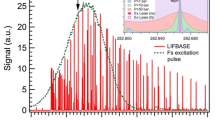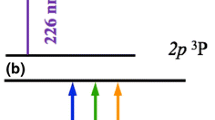Abstract
Planar laser-induced fluorescence (PLIF) is considered a standard experimental technique in combustion diagnostics. However, it has only been occasionally applied to explosion experiments with fast combustion regimes. It has been shown that single-shot OH-PLIF with high pulse energies yields clear fluorescence images of fast deflagrations and also detonations. This paper presents the first application of high-speed OH-PLIF at 20 kHz repetition rate to a deflagration-to-detonation transition experiment. Hydrogen–air mixtures at initial atmospheric pressure and ambient temperature are investigated. Satisfactory results are obtained for flame speeds up to about 500 m/s. Flame instabilities and turbulence–flame interactions are observed. Two factors limit the applicability of HS OH-PLIF toward higher flame speeds: excessive flame luminescence masking the HS OH-PLIF signal and strong absorption of laser light by the flame. The variation in OH-PLIF signal-to-background ratio across a DDT process is studied using a 1D laminar premixed flame simulation extended by spectroscopic models.











Similar content being viewed by others
References
Boeck LR (2015) Deflagration-to-detonation transition and detonation propagation in \(\text{H}_2\)–air mixtures with transverse concentration gradients. Ph.D. Thesis, Technical University of Munich
Daily JW (1997) Laser induced fluorescence spectroscopy in flames. Prog Energy Combust 23:133–199
Eckbreth AC (2001) Laser diagnostics for combustion temperature and species, 2nd edn. Gordon and Breach, London
Eder A (2001) Brennverhalten schallnaher und überschall-schneller Wasserstoff-Luft Flammen. Ph.D. Thesis, Technical University of Munich
Fiala T (2015) Radiation from high pressure hydrogen–oxygen flames and its use in assessing rocket combustion instability. Ph.D. Thesis, Technical University of Munich
Fiala T, Nettinger M, Rieger F, Kumar A, Sattelmayer T (2014) Emission and absorption measurement in enclosed round jet flames. 16th ISFV, Okinawa, Japan
Fiala T, Sattelmayer T (2013) On the use of OH* radiation as a marker for the heat release rate in high-pressure hydrogen–oxygen liquid rocket combustion. 49th AIAA/ASME/SAE/ASEE Joint Propulsion conference and Exhibit, San Jose, CA, USA
Goodwin DG, Moffat HK, Speth RL (2016) Cantera: an object-oriented software toolkit for chemical kinetics, thermodynamics, and transport processes. http://www.cantera.org. Version 2.2.1
Johansen CT, Ciccarelli G (2009) Visualization of the unburned gas flow field ahead of an accelerating flame in an obstructed square channel. Combust Flame 156:405–416
Jomaas G, Law C, Bechtold J (2007) On transition to cellularity in expanding spherical flames. J Fluid Mech 583:1–26
Kathrotia T, Fikri M, Bozkurt M, Hartmann M, Riedel U, Schulz C (2010) Study of the H+ O+ M reaction forming OH*: kinetics of OH* chemiluminescence in hydrogen combustion systems. Combust Flame 157:1261–1273
Katzy P, Boeck LR, Hasslberger J, Sattelmayer T (2016) Application of high-speed OH-PLIF technique for improvement of lean hydrogen–air combustion modeling. 24th ICONE paper 60130
Kohse-Höinghaus K, Jeffries JB (eds) (2002) Applied combustion diagnostics. Taylor & Francis, New York
Lin HM, Seaver M, Tang KY, Knight AEW, Parmenter CS (1979) The role of intermolecular potential well depths in collision-induced state changes. J Chem Phys 70:5442–5457
Mével R, Davidenko D, Lafosse F, Chaumeix N, Dupré G, Paillard CÉ, Shepherd JE (2015) Detonation in hydrogen–nitrous oxide-diluent mixtures: an experimental and numerical study. Combust Flame 162:1638–1649
Mével R, Davidenko D, Austin JM, Pintgen F, Shepherd JE (2014) Application of a laser induced fluorescence model to the numerical simulation of detonation waves in hydrogen–oxygen-diluent mixtures. Int J Hydrog Energy 39:6044–6060
Ó Conaire M, Curran HJ, Simmie JM, Pitz WJ, Westbrook CK (2004) A comprehensive modeling study of hydrogen oxidation. Int J Chem Kinet 36:603–622
Paul PH, Durant JL, Gray JA, Furlanetto MR (1995) Collisional electronic quenching of OH A\(^{2}\Sigma\) (v’ = 0) measured at high temperature in a shock tube. J Chem Phys 102:8378–8384
Pintgen F, Shepherd JE (2009) Detonation diffraction in gases. Combust Flame 156:665–677
Pintgen F (2004) Detonation diffraction in mixtures with various degrees of instability. Ph.D. Thesis, California Institute of Technology
Pintgen F, Eckett CA, Austin JM, Shepherd JE (2003) Direct observations of reaction zone structure in propagating detonations. Combust Flame 133:211–229
Pintgen F (2000) Laser-optical visualization of detonation structures. Diploma Thesis, Technical University of Munich—California Institute of Technology
Rothman LS, Gordon IE, Barbe A (2009) The HITRAN 2008 molecular spectroscopic database. J Quant Spectrosc Ra 110:533–572
Vollmer KG (2015) Einfluss von Mischungsgradienten auf die Flammenbeschleunigung und die Detonation in Kanälen. Ph.D. Thesis, Technical University of Munich
Vollmer KG, Ettner F, Sattelmayer T (2012) Deflagration-to-detonation transition in hydrogen–air mixtures with concentration gradients. Combust Sci Technol 184:1903–1915
Acknowledgments
The presented work is funded by the German Federal Ministry of Economic Affairs and Energy (BMWi) on the basis of a decision by the German Bundestag (Project No. 1501425) and by the German Research Foundation (DFG) in the framework of Sonderforschungsbereich Transregio 40, which is gratefully acknowledged.
Author information
Authors and Affiliations
Corresponding author
Appendices
Appendix 1: Fast flame in the obstructed channel
An additional experiment was performed to visualize the contributions of OH-PLIF and flame luminescence signals in case of a fast flame in the obstructed channel geometry. The camera and intensifier were operated at a framing rate of 40 kfps, whereas the OH-PLIF laser operated at 20 kHz so that every other camera frame experienced a laser pulse. Figure 12 presents three images from this sequence. Frames 1 and 3 show flame luminescence only, and frame 2 shows the sum of flame luminescence and OH-PLIF signal. The flame propagates at about 700 m/s toward the obstacle located at the end of the field-of-view. For a quantitative analysis, the images are Gauss-filtered \((\sigma =6)\) to reduce the influence of image intensifier noise. Intensities are then plotted in Fig. 13 for five vertical positions (\(y=6\), 18, 30, 42, 54 mm), indicated in Fig. 12. In frame 1, the flame tip is located at \(x\approx 50\) mm. Ahead of the flame, \(x>50\) mm, registered intensities remain below 30 counts. Where the flame is present, \(x<50\) mm, intensities fluctuate around 200–600 counts. In frame 2 both OH-PLIF signal and flame luminescence contribute to the registered intensity. Peak values reach 2500 counts at \(y=54\) mm. The following two heights, \(y=42\) and 30 mm, show similar peak intensities. At \(y=18\) mm and \(y=6\) mm, the peak intensity drops to 1420 counts and 1150 counts, respectively. This drop can be attributed to absorption of laser light as it passes through the flame and combustion products from top to bottom. Frame 3 again shows flame luminescence only with peak values of about 600 counts. Consistent with Eq. 2, the SBR is expressed as the ratio of OH-PLIF signal and flame luminescence signal, where the former is the difference between registered peak intensities in frame 2 (1150–2500 counts) and the background signal (600 counts). The latter is the background signal (600 counts). This leads to SBRs of 0.9, 1.4, 2.7, 3.0, and 3.2 for positions \(y=6\), 18, 30, 42, 54 mm, respectively.
Intensity profiles for vertical positions \(y=6, 18, 30, 42, 54\) mm in Fig. 12, frames 1–3
Appendix 2: Spectroscopic models for SBR evaluation
This section describes the spectroscopic models and approach employed to estimate the variation in the SBR between three cases representative of the experimental conditions. To estimate this ratio, we calculated the variation in the absorbed incident light intensity (or fluorescence intensity), on the one hand, and the variation in the concentration of chemically/thermally excited OH*, on the other hand.
Under most experimental conditions presently studied, the flame structure can be considered as essentially laminar. The Cantera software (Goodwin et al. 2016) is used to compute the freely propagating laminar flame structure. By including in the detailed reaction (Ó Conaire et al. 2004) the submechanism for OH* formation (Kathrotia et al. 2010), the contributions of the chemically/thermally excited OH* radical are directly obtained along the flame from the 1D flame calculation. The chemical and thermal pathways to form OH*, discussed by Fiala and Sattelmayer (2013), are, respectively, given by
where Chem is chemical excitation, Diss is dissociative de-excitation, Therm is thermal excitation, and Quen is quenching or collisional de-excitation.
To estimate the fluorescence intensity, we calculated the laser light absorption along the 1D flame using the Beer–Lambert law
where \({I}_{{ d}}\) is the laser intensity at the distance \({d}_{{ i}}\), \({I}_{{ d}}\) is the laser intensity at the distance \({d}_{{ i-1}}\), \(\sigma _{\mathrm{OH}}\) is the total local absorption cross section of OH radical over the optical pathlength \(\ell ={d}_{{ i}}-({d}_{{ i-1}})\), i is the grid point number, and \({f}_{\mathrm{b}}\) is the Boltzmann fraction
where \({g}''\) is the statistical weight of the lower state, \({c}_{2}\) is the second radiative constant, \(E''\) is the lower state energy, T is the temperature and \({Q}_{{ \mathrm p}}\) is the partition function.
Presently, we considered that the local intensity of fluorescence is proportional to the intensity of the incident light which is absorbed over \(\ell\) divided by the collisional quenching rate, Q
where Q is given by Paul et al. (1995)
The temperature dependence of the collisional quenching cross section, \(\sigma _{{ Qi}}\), is described using the formalism of Lin et al. (1979)
where \(\sigma _{{ Qi}}(\infty )\) is the collisional quenching cross section of the i species at infinite temperature, and \(\frac{\epsilon }{{k}_{{ Q}}}\) is the temperature dependence parameter in the Lin et al. collisional quenching cross section expression.
The initial incident light intensity is expressed as a normalized spectrally resolved laser line shape, \(L_{L}\), which is assumed to be Gaussian
where \(\nu _{\mathrm{Inci}}\) is the frequency of the incident light, \(35334.41483\hbox { cm}^{-1}\), and \(\Delta \nu _{{ L}}=0.22\,\hbox{cm}^{-1}\) is the laser line width, as indicated from the laser supplier. Note that the integral of \(L_{L}\) in the wavenumber space is equal to unity.
In addition to the absorption by the \({Q}_{1}\)(6) absorption line, the contributions of the \({Q}_{2}\)(1), \({Q}_{2}\)(3), \({Q}_{12}\)(1), \({Q}_{12}\)(3) and \({Q}_{21}\)(6) transitions were taken into account. For each line j, the spectrally resolved absorption cross section, \(\sigma _{{\mathrm{{OH}}}}^{j}\), was calculated along the flame from
where \({S}^{{ j}}\) and \(\varPsi ^{{ j}}\) are, respectively, the line strength and the line shape function of the transition j.
The line strength of a transition at a given temperature T is obtained from
where \({T}_{\mathrm{ref}}=296\hbox { K}\) is the reference temperature, and \(\nu _{0}\) is the absorption line center frequency.
The absorption line shape functions were described using the Voigt profile
where V(a, x) is the Voigt function
with
and
where \(\Delta \nu _{\mathrm{D}}\) is the Doppler line width, \(\Delta \nu _{\mathrm{C}}\) is the collision line width.
The Doppler and collision line widths were, respectively, calculated from
and
where \(2\gamma _{{ i}}\) is the collision coefficient of the i species, and \({P}_{{ i}}\) is the partial pressure of the i species.
All spectroscopic parameters for each absorption line were taken from the HITRAN database (Rothman et al. 2009).
Rights and permissions
About this article
Cite this article
Boeck, L.R., Mével, R., Fiala, T. et al. High-speed OH-PLIF imaging of deflagration-to-detonation transition in H2–air mixtures. Exp Fluids 57, 105 (2016). https://doi.org/10.1007/s00348-016-2191-z
Received:
Revised:
Accepted:
Published:
DOI: https://doi.org/10.1007/s00348-016-2191-z






